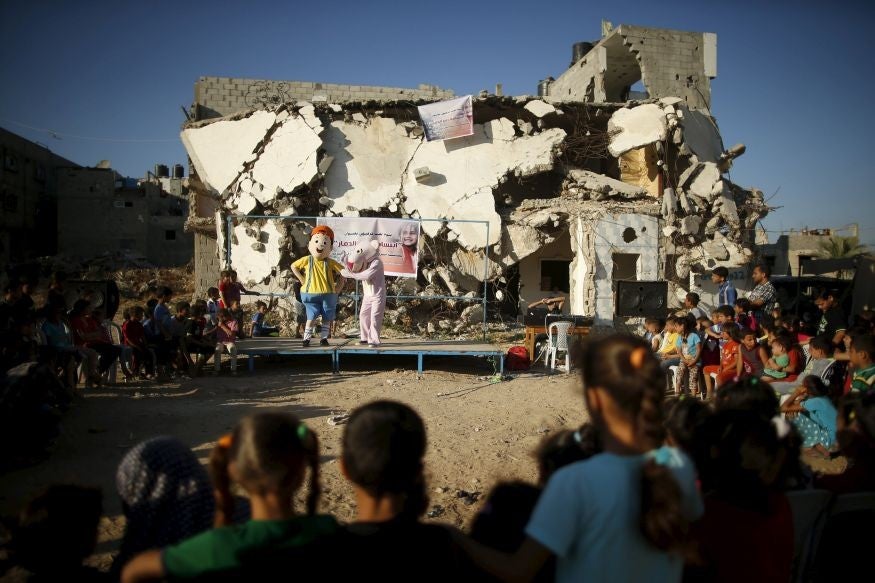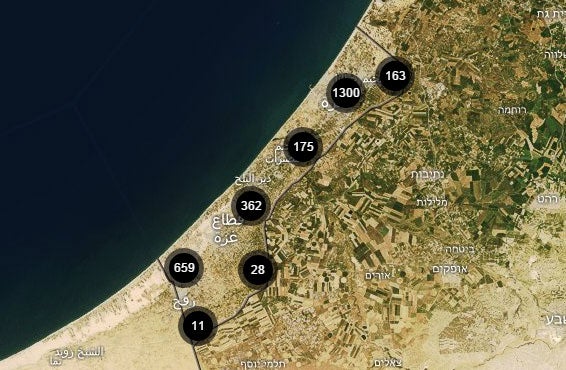Amnesty International uses 'The Gaza Platform' map to visualise every Israeli strike on Gaza
The map plots 2,500 separate strikes that occurred during last year's conflict

Your support helps us to tell the story
From reproductive rights to climate change to Big Tech, The Independent is on the ground when the story is developing. Whether it's investigating the financials of Elon Musk's pro-Trump PAC or producing our latest documentary, 'The A Word', which shines a light on the American women fighting for reproductive rights, we know how important it is to parse out the facts from the messaging.
At such a critical moment in US history, we need reporters on the ground. Your donation allows us to keep sending journalists to speak to both sides of the story.
The Independent is trusted by Americans across the entire political spectrum. And unlike many other quality news outlets, we choose not to lock Americans out of our reporting and analysis with paywalls. We believe quality journalism should be available to everyone, paid for by those who can afford it.
Your support makes all the difference.An interactive map created by human rights group Amnesty International has shown every attack on Gaza by Israeli forces during the 2014 Gaza conflict.
The conflict, named 'Operation Protective Edge' by Israel, killed 2,310 Gazans, around half of them fighters. 66 Israeli soldiers and six Israeli civilians were killed during the conflict, which lasted a little under two months.
The map, named The Gaza Platform and unveiled today, was created by Amnesty International and Forensic Architecture, and aims to push for accountability for war crimes and breaches of international humanitarian law that may have occurred during the conflict.
The map works by recording the time and location of each attack, classifying it based on the type of attack, the type of site that was struck, and the number of casualties it incurred.

The data was put together over several months, based on records taken by Gaza-based human rights organisations and Amnesty International itself.
When taken together, it forms a comprehensive database of over 2,500 attacks during the 2014 conflict, a number that will grow as more data is added to the map.
Phillip Luther, the Director of Amnesty International's Middle East and North Africa programme, said it "has the potential to expose the systematic nature of Israeli violations committed during the conflict."
He added: "Our aim it for it to become an invaluable resource for human rights investigators pushing for accountability for violations committed during the conflict."
Amongst other patterns, the map reveals the number of artillery strikes that occurred during the confluct. 270 Israeli attacks were carried out in this way, killing 320 civilians.
Francesco Sebregondi, the director of the project at Forensic Architecture, said the map "exploits the power of new digital tools to shed light on complex events such as the latest war in Gaza."
"It enables users to move across scales, from the granular details of each incident to the big picture of the overall conflict, by revealing connections between scattered events."
It is hoped that by using data in conjunction with the real-life stories from the ground during the conflict, more international attention will be drawn to the possible crimes that were committed there.
The conflict ended more than a year ago, but its impact still affects the everyday lives of Gazans, many of whom are suffering from the effects of water shortages and damaged infastructure.
Join our commenting forum
Join thought-provoking conversations, follow other Independent readers and see their replies
Comments